

Human Factors is a broad subject aimed at improving Human Performance. While several organizations have developed ways of structuring this topic, three main categories are being suggested that incorporate much of the current thinking. These are Facilities and Equipment, Processes, and People. The elements that fall into these categories range from six to 28 in number, depending on how these elements are bundled. The People category includes leadership and culture building, supervision and behavior, fatigue and fitness for duty, and training and competence.
This paper will focus on training and competence of people as related to Problem Based Learning for Process Safety Management.
In spite of millions of dollars spent, the vast majority of PSM training strategies and methods continue to rely on less than optimal one-way lectures and PowerPoint® teaching methods. This paper will offer three fundamental elements for learning that are too often overlooked and misunderstood but have a direct impact on human performance. These are Problem Solving as an instructional strategy (a natural method of learning), Skill Transfer (to the job), and Business Expectations from learning.
It’s time to rethink the relationships beyond the jargon and old teaching methods and focus on measurable business improvements using proven methods applied to successful organizations.
Definitions
- Natural method of human learning. Use the natural human method of solving problems as the instructional strategy to ensure student experiences improve learning. Business schools call this instructional strategy the Case Study method and trade schools call it Apprenticeships. The key here is that real life scenarios bring fidelity, motivation and higher intellectual skills to the content and strategies expected in the workplace.
2. Transfer skills. Without skill transfer to the job, there is no learning. Training is a measure of the potential to perform, not of performance. Businesses do not succeed because they have potential, but because they produce results. The fundamental focus between the business unit and training should be a partnership, which takes place well before as well as after taking the training. There is too much “white space” on the organizational chart between training and operational departments.
- Business expectations. Never forget what the business units expect from training. They expect:
- More production at less cost
- Less time off the job and in the classroom.
- Accepting personal responsibility for one’s behavior
- More participatory decision making using work teams
- Increased use of problem solving and critical thinking skills, not memorization.
- Matching training activities to job site realities
